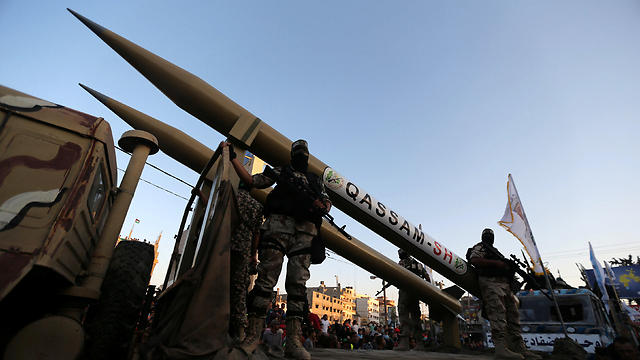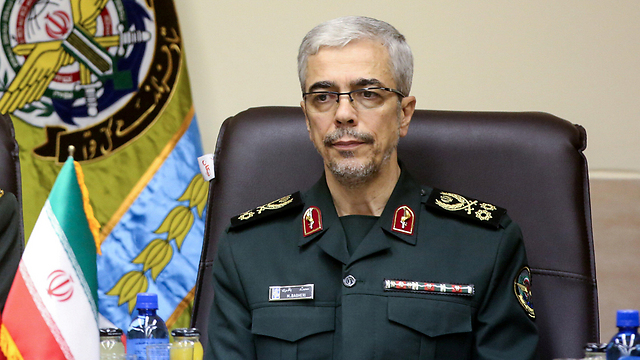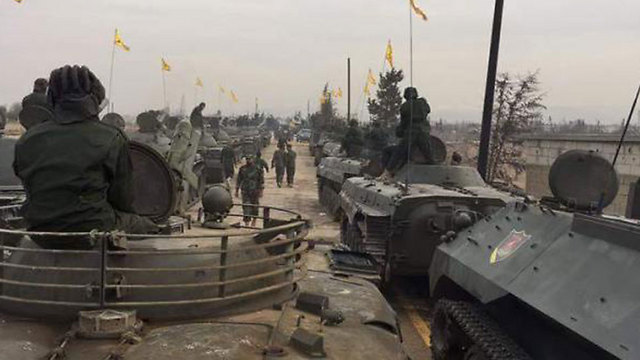

Israel’s next challenge: Precision-guided missiles in Gaza
Analysis: As part of its expansion in the region, Iran plans to produce upgraded rockets in Syria, Lebanon and Yemen. In light of the Iranians' warming relations with Hamas, Israeli defense officials believe they will seek to produce accurate missiles in the strip as well. Meanwhile, Hezbollah already has its eyes set on the day after the war in Syria.
The Iranian issue has recently made its way back to the top of the global agenda in general, and the Israeli agenda in particular: Starting from US President Donald Trump’s threats to walk away from the nuclear agreement, through Tehran’s involvement in Syria, Iraq, Lebanon and Yemen and the warming relations with Hamas, to the growing presence of Revolutionary Guards’ representatives on the Golan Heights border.
Looking at this list as it grows longer, many Israeli defense officials believe the most significant challenge concerning Iran these days has to do with the potential for self-production of precision-guided weapons—converting simple rockets, through wingtip devices and other components, into missiles that are capable of hitting their target with an accuracy of some tens of meters. In light of the tight connection to Hezbollah and the improving relations with Hamas, this a very troubling weapon as far as Israel is concerned.
The knowledge required for upgrading the missiles already exists, and Iran’s military industry factories are advanced in this field. In addition to its expansion in the region, Iran intends to produce rockets in Syria too and set up a factory in Lebanon to perform the conversion into precision-guided missiles.
This plan isn’t limited to the Lebanese-Syrian arena. Iran wants to build similar factories in Yemen for its allies, the Houthi rebels, who still control different areas, including the capital of Sanaa, and are in a war against the Saudi-led coalition and the forces of Yemen’s official president, Abdrabbuh Mansour Hadi.
Against this background, Israel is watching the Gaza Strip with a great amount of concern: As part of the warming relations with Hamas, Iran will likely seek to produce precision-guided missiles in Gaza too. Only recently, during a visit by senior organization members to Tehran, the Iranian foreign minister’s advisor, Hussein Sheikh al-Islam, promised that “Iran will give Hamas whatever Hamas asks for and Iran can comply with.”
At the moment, there is no concrete operation taking place in Lebanon, Yemen or Gaza, but the planning and thought do exist. According to foreign sources, the Israel Air Force occasionally strikes in Syria to prevent the transfer of components and weapons aimed at helping in Hezbollah and Iran’s effort.
Russia caught between Assad and Israel
Furthermore, the Israeli defense establishment is concerned by a possible deployment of Iranian elements and pro-Iranian forces in the Golan Heights, a move which is likely only in its infancy. It’s still unclear who was responsible for the rockets fired into Israel from Syria on Saturday. In any event, the Syrian Golan Heights is currently filled with a mixture of elements: Some of the areas are controlled by the regime (especially in the northern and central Golan), other areas are in the hands of rebel groups sitting just along the border in the central Golan, and the ISIS-affiliated Khalid ibn al-Walid Army is waiting on the tripoint in the southern Golan.
The Syrian regime is trying to regain territory in the Golan. There have been many reports recently on massive bombings carried out by the regime near the town of Beit Jann, at the foot of the Syrian Mount Hermon. Syrian President Bashar Assad appears to be progressing in a relatively fixed manner, which has been successful in other areas in Syria too: Shelling and an ongoing siege on a village until its residents surrender.
A key role in this battle is played by Russia, the dominant element in the area known as “Assadstan” (the areas controlled by the regime, although they don’t necessarily have an abundance of members of the Alawi sect which the tyrant’s family comes from). The Russian goal is likely to reach an agreement and restore the Syrian regime’s control in the Jordanian and Israeli border areas.
As Russia has no desire to create an escalation with Israel, its interest is to pressure Iran and Hezbollah to dilute their forces in those areas. The problem is it still needs their forces as the rebels have yet to be fully eradicated.
Despite many reports of cracks in the relations between Russia, Iran, Hezbollah and the Assad regime, the cooperation continues as all parties share the same interest: To secure the Assad regime’s survival. It’s clear, however, that each party has different interests and different aspirations.
Russia is interested in preserving its port on the Syrian coast in the Mediterranean Sea. Iran is interested in expanding in Syria and creating a platform against Israel. Assad may be more committed to Tehran than in the past, but contrary to the prevalent opinion, he has yet to open all doors to them and has yet to completely give up his assets.
An interesting example emerged during a recent visit to Damascus by the Iranian military’s chief of staff, General Mohammad Baqeri. While the visit received wide media coverage, the agreements with the Syrians were apparently only in principle and no official documents were signed.
The Hezbollah enigma
The fourth element in the equation is Hezbollah, which has invested—and is still investing—many resources in the civil war in Syria, led by its elite unit, the Radwan force. The involvement in Syria has already cost the Shiite organization 2,000 fighters, almost three times the number of Hezbollah fighters killed in the Second Lebanon War.
In the past few years, it has often been reported that Hezbollah is pulling its forces out of Syria, but the organization is still there, and as its leader Hassan Nasrallah says, his people will be present wherever they are needed.
Nevertheless, they have likely started to think about the day after. It seems Hezbollah isn’t interested in continuing its massive presence in Syria, but rather in diluting its forces. An Iranian presence in the area, along with a reduction in the Russian presence, will be convenient for Nasrallah, who will have no problem stationing his people in observation posts on the Golan Heights, and this situation should concern Israel in any event.
The organization has yet to appoint a replacement to the head of its military wing, Mustafa Badreddine, who was mysteriously assassinated in May 2015 in the Damascus Airport. The two people running Hezbollah’s efforts in Syria these days are believed to be Nasrallah himself and the commander of the Revolutionary Guards’ Quds Force, Qasem Soleimani, who is already being defined by some people as Iran’s “sanctum” in the Middle East.



















